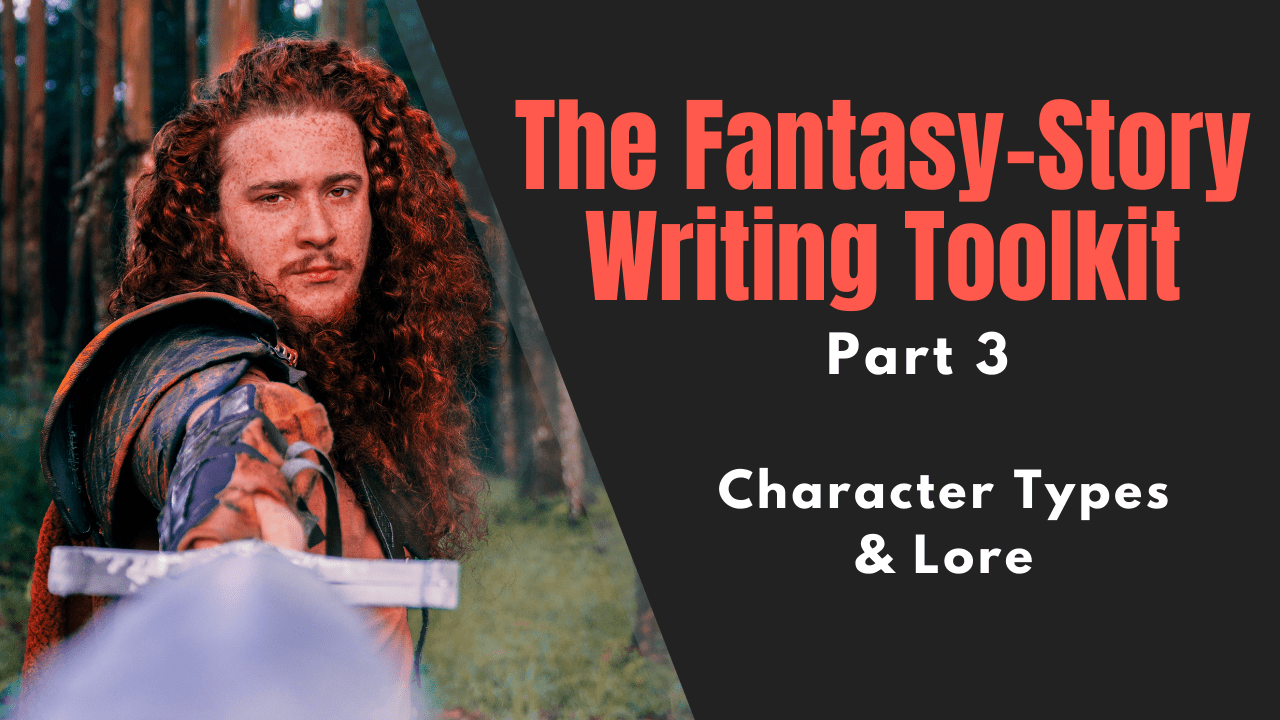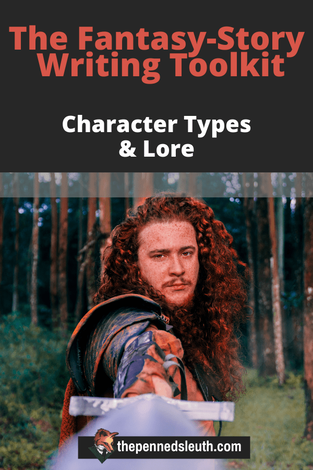Latest Writing Video! |
|
It’s time to wrap up the series with a look at the different characters one can find in the fantasy genre as well as a closer look at what lore is. We’ve covered a lot so far, but the characters and backstory of your novel are crucial. If you are struggling to come up with interesting characters, or round out the story of the world and its inhabitants, this post has what you need. With that said, let’s begin! Pin for Later!NOTEThis is the third and final part of this series, so if you haven’t already, be sure to check out the first two parts. In those posts, we covered the bigger picture of your fantasy world, discussing world types and magical systems, magical creatures, races, deities, fantasy world structures and fantasy plot types. There is also a discussion on how to name everything if you plan to create a massive, in-depth world. And if you are looking for some hands-on practice or guidance with your novel, I recommend checking out my writer's workshop. There are various options for you to choose from, like enrolling in my writing courses, joining the writing group or joining my tutoring program, where you and I have private video lessons discussing your book. Character Types:In this segment of the video, I will be talking about the types of characters that are often used in the fantasy genre. I would like to call it a trope to use a certain combination of personalities because it has been used so often that whenever I see them in such a story I can’t help but feel that they have become the ‘industry standard’ for these types of story. With that being said, let’s tackle the first character type! The Determined LonerThe Determined Loner; is a character who has had a difficult life, who has been wronged in the past and decides to make things right by pursuing an opportunity that presented itself. It could be that someone needs their help, so they help them to find inner peace with what happened or so they can target someone else with the aggression they feel towards the one that wronged them. Or perhaps it is a story of revenge and the loner is determined to take down the antagonist. Typically, the Determined Loner attracts other characters with their goal or values, which in turn changes the Determined Loner into one of the other groups I will talk about later. For now, let’s drop the hypotheticals and talk about the pros of having a singular main character. First; it is easier to write such a story, for obvious reasons. Having one character to manage is a lot more comfortable and easy to plan for than the many moving parts that multiple main characters present. Second; most stories are better suited for singular characters. It is usually the grander stories that have more characters, especially if the plot involves the fate of a lot more than a single character. Third; with most, if not all, of the focus on one character, you can develop that character a lot better than if you were to split the attention to several characters. There will be more scenes surrounding that character and depending on the perspective you choose, you can have more insight into that character’s thoughts and emotions. Finally, a con with writing a story with a single main character. These are stories that quickly grow tiresome when the story goes on too long. The benefit of having other characters is that you can constantly renew interest with a new scene developing another character. It could be a scene where the main characters have an exchange with some side characters, or it could be an exchange between the main characters. For this reason, stories with a single character to focus on aren’t lengthy novels. The only way to extend reader interest is by introducing new and interesting characters along the way, bringing with them new problems to be resolved. The Undefeatable DuoAll these problems are alleviated when one adds an additional main character. In this segment, we will be talking about the Undefeatable Duo. Two characters who work together to achieve some greater goal. The Undefeatable Duo can come in two flavours; either the two characters are fast friends, old friends or family members, in which case the reader watches their teamwork throughout the story. The second option is the buddy-cop option, where the two characters don’t like each other in the beginning, but grow into a formidable partnership by the end of the novel. I enjoy writing stories that are centred around two characters and their adventure. There is still an opportunity to create slow scenes exploring a character's personality with the same closeness as one would with a single main character. Yet, there is also enough room to create more conflicts, as there are now two characters with different values and opinions countering each other. Typically, the Undefeatable Duo will be opposites in at least one respect. It could be one is more intelligent and the other more physically strong. One could be the good cop and the other is the bad cop. You get the idea. These differences help create the conflicts between the two, which will most likely be resolved. The Troublesome TrioAdding another character and you have the Troublesome Trio, the most common character trope in fiction. Usually, the three characters are built like this; one is smart/skilled/refined/high-strung, and the next is slow/funny/oafish/casual. The third is a bit of both. It’s this third character that is a bit less extreme when it comes to their personality, which makes them the ideal choice for the main character of Trio. Examples of this trio can be found almost anywhere. Aragorn, Legolas and Gimli from Lord of the Rings. Harry, Hermione and Ron from Harry Potter. Percy, Annabeth and Grover from the Percy Jackson Series. The Ever-growing ArmyNow, I can keep counting up with the tropes, but I think you get the idea. With each new character, it is a good idea to make them stand out by having a different style and personality from the other characters. It makes them interesting and recognisable amongst the other characters. The final stage is the Ever-growing Army. I call it this because you normally find all these characters and their respective factions banding together to tackle some greater conflict. These are characters that the main character encounters and bonds with on their journey. It could be the main character helping them with their conflict or they simply take a liking to each other. With so much time spent on these separate scenes, the characters get enough focus and interest to make them an important part of the story. From there, they might join the character on their journey or meet up with them at the end. The Ever-growing Army is only limited by the creativity and patience of the writer, so you can have ten or more main characters by the end of the story. Tips for Writing CharactersIf you are still creating your story, I hope this information on different character types helps or inspires you with creating your characters. If you already have characters in mind, here are a few tips that might help you when writing the. There are three things you need to ensure regarding your characters. First, you need to be consistent with their personality and values. If your character makes a decision, or if they use phrases or make responses that don’t match their personality, it can make for a jarring scene. This is why most writers make their personalities so unique. One can also create character notes and, for difficult scenes, take the time to put themselves in the character's shoes. Second, a great character will learn something throughout the story. Character development is important. It could be they learn to be a little nicer, or a little tougher. What they learn is up to you, but whatever it is, it will take that character to a new level in the reader’s eyes. Third, maintain your interest in the main character. Often, a writer will turn their main character into a hollow character, lacking personality and simply playing their role in the story. If you find yourself losing interest in your character, chances are the reader is as well. The Lore:Ah, lore. I have talked about it many times before and referenced it in the previous parts of this fantasy toolkit. Lore is a backstory, it is the foundation of your world, it is the history, the culture, the beliefs, the mannerisms and traditions. If you add depth to any element of your world, you are adding to its lore. As I have covered many elements of lore in this toolkit, I will only address one important element… How much lore should a story have?Lore is a niche element. Some readers only want the general idea, a simple layout of a world and how it works. Other readers want to know the reasons and the stories behind all these elements. The question of how much lore is enough entirely depends on you and your target market. If you enjoy writing lore, crafting a relaxed scene where characters discuss history, then you can write as much lore as your heart desires. There will always be a reader that smiles and read it with great interest. If that’s what you enjoy, your only challenge is interestingly presenting the lore, as too much exposition will chase every reader away. However, if you are the kind of writer that doesn’t want to go so in-depth, that is great as well. On the other side of the spectrum, some readers want to stay in the moment. Readers who want to follow what the characters are doing now. All they need is a general idea of how it all works so the following scenes are easy to follow. Tips for Writing LoreNow, some simple, dependable advice for writing lore. If you want to create history behind your world, you need to create a timeline. Use dates, even if it is only the years, to keep track of every major event. Create information sheets on different factions and their relations over the years and during these events. Write it for yourself, that way you can better keep track of everything when you are trying to present the information to the reader. It goes without saying, but I will say it anyway; if you end up writing pages of this information you need to ensure you don’t lose it. Save it in a document, store it digitally over the internet, or keep it in a book that you have with you. When you are writing your story, be sure to look at these notes you made often. The more complex your lore, the easier it is to contradict yourself. A reader who is paying attention will notice this contradiction and the confusion will spoil the story if that lore is important to the plot. Finally, the simplest plots are often the best. If you have such a diverse world with intense lore, it might be better to only emphasise the information that pertains to the story. The rest of the lore can be used in a different story or used as background information for creating immersion. What Next?And that concludes the final part of the fantasy toolkit series!
I hope you enjoyed the series and found all the information helpful. I understand there are various elements to every story and most elements you might have covered, but if any of these posts helped you tackle an element you were struggling with, that makes me happy. I would also like to hear what elements I might have missed out on during this series that you would like covered. What advice you would give beginner writers who want to write in the fantasy genre. Let me know in the comments! And, if you haven’t already, be sure to check out the new free course available on my website. In this course, I talk a lot more about these elements in fantasy writing, so if you’re interested to learn more, claim your free course! Thank you so much for reading and as always, Good day, goodnight and happy writing!
0 Comments
Leave a Reply. |







